高考英语一般现在时用法详解(1)
- 格式:doc
- 大小:63.50 KB
- 文档页数:8

【备战高考】英语一般现在时用法总结(完整)一、单项选择一般现在时1.The palace caught fire three times in the last century, and little of the original building________ now.A.is remained B.is remainingC.remains D.has been remained【答案】C【解析】【详解】考查时态语态。
句意:上个世纪这座宫殿着火三次,原来的建筑几乎什么也不剩了。
本句中动词remain意为“剩余”,没有被动语态,也不能用于进行时态。
根据句中时间状语now 可知本句应该使用一般现在时的时态,故C项正确。
2.During the quality time at night, the father enjoys watching TV, while the mother together with her three children fond of listening to popular songs.A.is B.are C.was D.were【答案】A【解析】考查主谓一致和时态。
当主语后带有together with短语时,句中的谓语仍然和前面的主语一致,不受together with短语的干扰。
根据enjoys可知,第二个分句也应用一般现在时。
3.Whenever you ______ a present, you’d better think about it from the receiver’s preference. A.bought B.buy C.will buy D.have bought【答案】B【解析】试题分析:句意:每当你买礼物的时候,你最好从接收方的偏好想一想。
whenever引导的让步状语从句,采用一般现在时表将来的用法。
故选B。
考点:考查动词的时态。
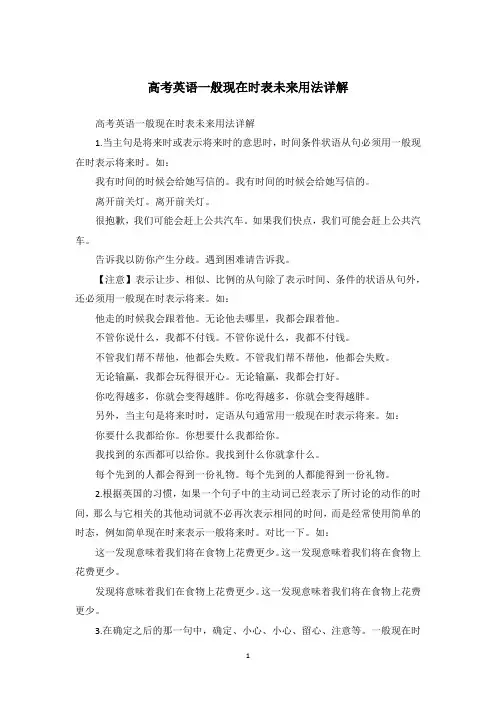
高考英语一般现在时表未来用法详解高考英语一般现在时表未来用法详解1.当主句是将来时或表示将来时的意思时,时间条件状语从句必须用一般现在时表示将来时。
如:我有时间的时候会给她写信的。
我有时间的时候会给她写信的。
离开前关灯。
离开前关灯。
很抱歉,我们可能会赶上公共汽车。
如果我们快点,我们可能会赶上公共汽车。
告诉我以防你产生分歧。
遇到困难请告诉我。
【注意】表示让步、相似、比例的从句除了表示时间、条件的状语从句外,还必须用一般现在时表示将来。
如:他走的时候我会跟着他。
无论他去哪里,我都会跟着他。
不管你说什么,我都不付钱。
不管你说什么,我都不付钱。
不管我们帮不帮他,他都会失败。
不管我们帮不帮他,他都会失败。
无论输赢,我都会玩得很开心。
无论输赢,我都会打好。
你吃得越多,你就会变得越胖。
你吃得越多,你就会变得越胖。
另外,当主句是将来时时,定语从句通常用一般现在时表示将来。
如:你要什么我都给你。
你想要什么我都给你。
我找到的东西都可以给你。
我找到什么你就拿什么。
每个先到的人都会得到一份礼物。
每个先到的人都能得到一份礼物。
2.根据英国的习惯,如果一个句子中的主动词已经表示了所讨论的动作的时间,那么与它相关的其他动词就不必再次表示相同的时间,而是经常使用简单的时态,例如简单现在时来表示一般将来时。
对比一下。
如:这一发现意味着我们将在食物上花费更少。
这一发现意味着我们将在食物上花费更少。
发现将意味着我们在食物上花费更少。
这一发现意味着我们将在食物上花费更少。
3.在确定之后的那一句中,确定、小心、小心、留心、注意等。
一般现在时通常只用来表示将来的意思。
如:注意不要让它再次发生。
小心不要再发生了。
我们必须注意不要让任何人看到我们。
我们必须小心,不要让任何人看到我们。
确保你很快回来。
你必须保证很快回来。
小心不要伤害她的感情。
小心不要伤害她的感情。
注意不要让婴儿靠近加热器。
注意不要让婴儿靠近加热器。
在开始答题之前,请注意仔细阅读考题。
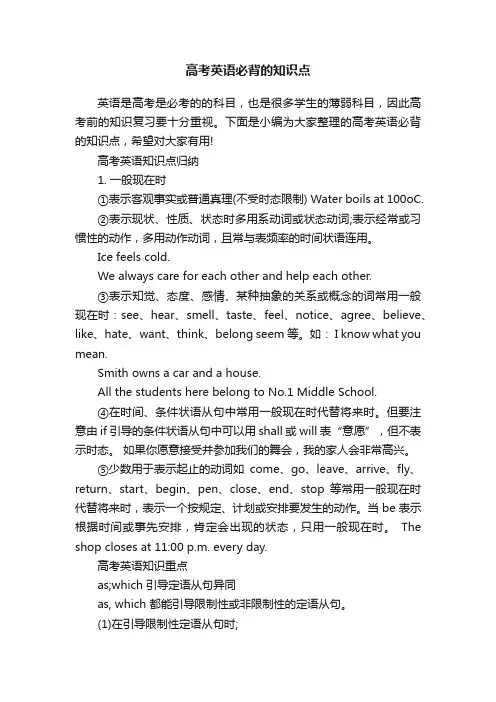
高考英语必背的知识点英语是高考是必考的的科目,也是很多学生的薄弱科目,因此高考前的知识复习要十分重视。
下面是小编为大家整理的高考英语必背的知识点,希望对大家有用!高考英语知识点归纳1. 一般现在时①表示客观事实或普通真理(不受时态限制) Water boils at 100oC.②表示现状、性质、状态时多用系动词或状态动词;表示经常或习惯性的动作,多用动作动词,且常与表频率的时间状语连用。
Ice feels cold.We always care for each other and help each other.③表示知觉、态度、感情、某种抽象的关系或概念的词常用一般现在时:see、hear、smell、taste、feel、notice、agree、believe、like、hate、want、think、belong seem等。
如: I know what you mean.Smith owns a car and a house.All the students here belong to No.1 Middle School.④在时间、条件状语从句中常用一般现在时代替将来时。
但要注意由if 引导的条件状语从句中可以用shall或will表“意愿”,但不表示时态。
如果你愿意接受并参加我们的舞会,我的家人会非常高兴。
⑤少数用于表示起止的动词如come、go、leave、arrive、fly、return、start、begin、pen、close、end、stop等常用一般现在时代替将来时,表示一个按规定、计划或安排要发生的动作。
当be表示根据时间或事先安排,肯定会出现的状态,只用一般现在时。
The shop closes at 11:00 p.m. every day.高考英语知识重点as;which引导定语从句异同as, which 都能引导限制性或非限制性的定语从句。
(1)在引导限制性定语从句时;①which从句修饰的先行词是名词(词组),which可与that换用,作宾语时可省去。
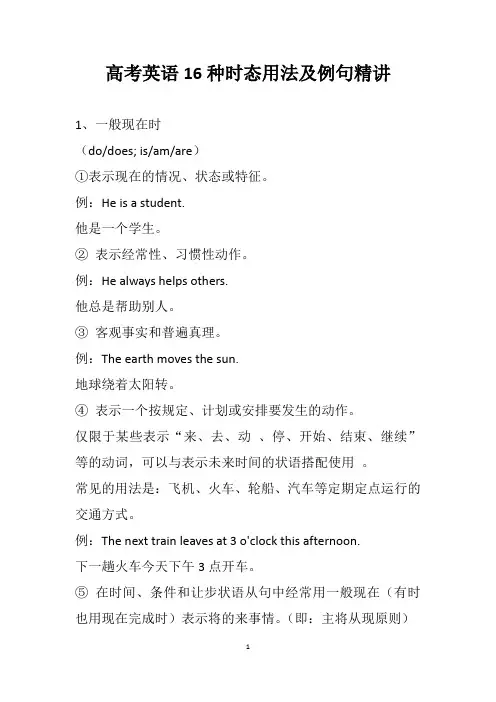
高考英语16种时态用法及例句精讲1、一般现在时(do/does; is/am/are)①表示现在的情况、状态或特征。
例:He is a student.他是一个学生。
②表示经常性、习惯性动作。
例:He always helps others.他总是帮助别人。
③客观事实和普遍真理。
例:The earth moves the sun.地球绕着太阳转。
④表示一个按规定、计划或安排要发生的动作。
仅限于某些表示“来、去、动、停、开始、结束、继续”等的动词,可以与表示未来时间的状语搭配使用。
常见的用法是:飞机、火车、轮船、汽车等定期定点运行的交通方式。
例:The next train leaves at 3 o'clock this afternoon.下一趟火车今天下午3点开车。
⑤在时间、条件和让步状语从句中经常用一般现在(有时也用现在完成时)表示将的来事情。
(即:主将从现原则)例:I will call you as soon as I arrive at the airport.我一到机场就会给你打电话。
When you have finished the report, I will have waited for about 3 hours.等你完成这份报告的时候,我就已经等了将近3个小时了。
2、现在进行时(am/is/are doing)①表示此时此刻正在发生的事情。
例:He is listening to the music now.他现在正在听音乐。
②表示目前一段时间内一直在做的事情,但不一定此时此刻正在做。
例:I am studying computer this term.这个学期我一直在学习计算机。
③现在进行时可以表示将来的含义。
a. 瞬时动词的进行一定表将来。
例:I am leaving.我要离开了。
b. 持续动词的进行只有有将来的时间状语或有将来语境中才表将来。
例:I am travelling next month.下个月我要去旅行。
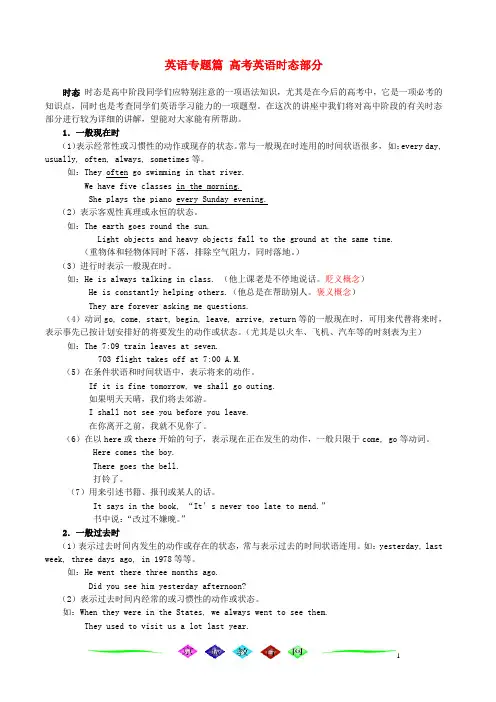
英语专题篇高考英语时态部分时态时态是高中阶段同学们应特别注意的一项语法知识,尤其是在今后的高考中,它是一项必考的知识点,同时也是考查同学们英语学习能力的一项题型。
在这次的讲座中我们将对高中阶段的有关时态部分进行较为详细的讲解,望能对大家能有所帮助。
1.一般现在时(1)表示经常性或习惯性的动作或现存的状态。
常与一般现在时连用的时间状语很多,如:every day, usually, often, always, sometimes等。
如:They often go swimming in that river.We have five classes in the morning.She plays the piano every Sunday evening.(2)表示客观性真理或永恒的状态。
如:The earth goes round the sun.Light objects and heavy objects fall to the ground at the same time.(重物体和轻物体同时下落,排除空气阻力,同时落地。
)(3)进行时表示一般现在时。
如:He is always talking in class. (他上课老是不停地说话。
贬义概念)He is constantly helping others.(他总是在帮助别人。
褒义概念)They are forever asking me questions.(4)动词go, come, start, begin, leave, arrive, return等的一般现在时,可用来代替将来时,表示事先已按计划安排好的将要发生的动作或状态。
(尤其是以火车、飞机、汽车等的时刻表为主)如:The 7:09 train leaves at seven.703 flight takes off at 7:00 A.M.(5)在条件状语和时间状语中,表示将来的动作。
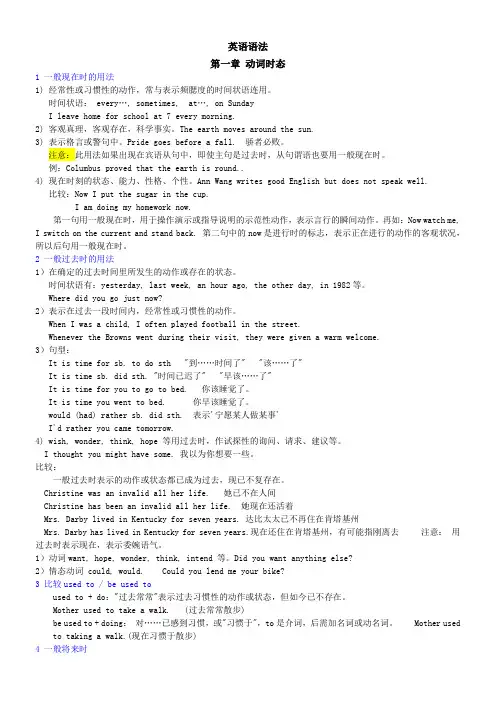
英语语法第一章动词时态1 一般现在时的用法1) 经常性或习惯性的动作,常与表示频腮度的时间状语连用。
时间状语: every…, sometimes, at…, on SundayI leave home for school at 7 every morning.2) 客观真理,客观存在,科学事实。
The earth moves around the sun.3) 表示格言或警句中。
Pride goes before a fall. 骄者必败。
注意:此用法如果出现在宾语从句中,即使主句是过去时,从句谓语也要用一般现在时。
例:Columbus proved that the earth is round..4) 现在时刻的状态、能力、性格、个性。
Ann Wang writes good English but does not speak well.比较:Now I put the sugar in the cup.I am doing my homework now.第一句用一般现在时,用于操作演示或指导说明的示范性动作,表示言行的瞬间动作。
再如:Now watch me, I switch on the current and stand back. 第二句中的now是进行时的标志,表示正在进行的动作的客观状况,所以后句用一般现在时。
2 一般过去时的用法1)在确定的过去时间里所发生的动作或存在的状态。
时间状语有:yesterday, last week, an hour ago, the other day, in 1982等。
Where did you go just now?2)表示在过去一段时间内,经常性或习惯性的动作。
When I was a child, I often played football in the street.Whenever the Browns went during their visit, they were given a warm welcome.3)句型:It is time for sb. to do sth "到……时间了" "该……了"It is time sb. did sth. "时间已迟了" "早该……了"It is time for you to go to bed. 你该睡觉了。
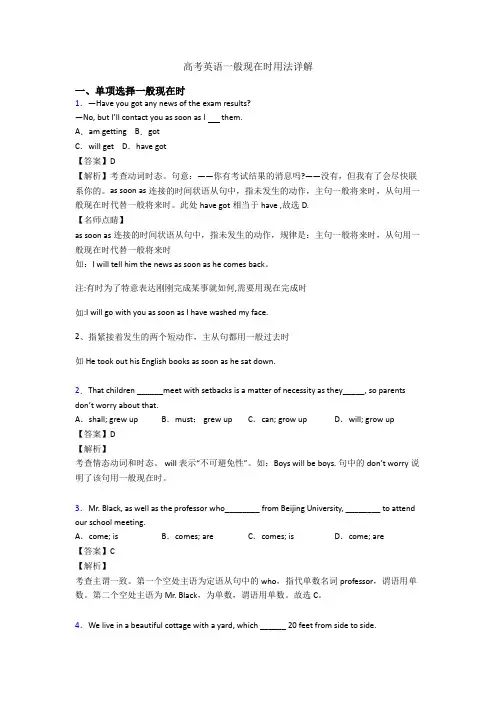
高考英语一般现在时用法详解一、单项选择一般现在时1.—Have you got any news of the exam results?—No, but I’ll contact you as soon as I them.A.am getting B.gotC.will get D.have got【答案】D【解析】考查动词时态。
句意:——你有考试结果的消息吗?——没有,但我有了会尽快联系你的。
as soon as连接的时间状语从句中,指未发生的动作,主句一般将来时,从句用一般现在时代替一般将来时。
此处have got相当于have ,故选D.【名师点睛】as soon as连接的时间状语从句中,指未发生的动作,规律是:主句一般将来时,从句用一般现在时代替一般将来时如:I will tell him the news as soon as he comes back。
注:有时为了特意表达刚刚完成某事就如何,需要用现在完成时如:I will go with you as soon as I have washed my face.2、指紧接着发生的两个短动作,主从句都用一般过去时如 He took out his English books as soon as he sat down.2.That children ______meet with setbacks is a matter of necessity as they_____, so parents don’t worry about that.A.shall; grew up B.must; grew up C.can; grow up D.will; grow up【答案】D【解析】考查情态动词和时态。
will 表示“不可避免性”。
如:Boys will be boys. 句中的don’t worry说明了该句用一般现在时。
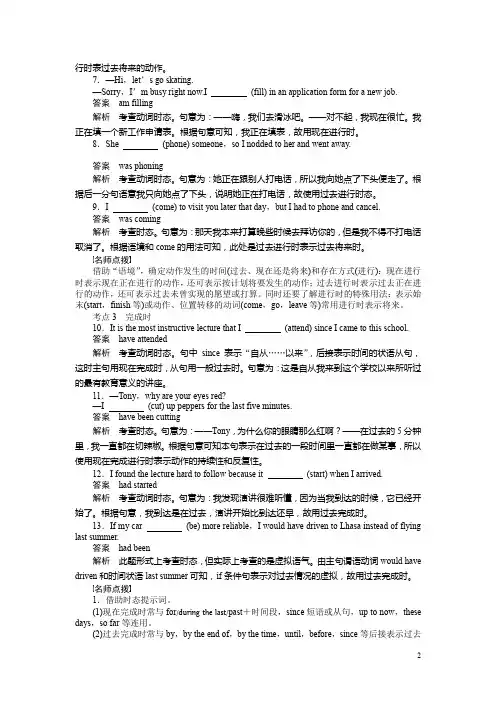
新课标高考英语语法动词的时态和语态高考真题例析动词的时态和语态考点1一般时1.On Monday mornings it usually (take) me an hour to drive to work although the actual distance is only 20 miles.答案takes解析句意为:通常在周一早上我要开一个小时的车去上班,尽管实际上只有二十英里的路程。
由usually以及从句时态,可知应用一般现在时。
2.I’m calling about the apartment you (advertise) the other day.Could you tell me more about it?答案advertised解析考查时态。
第一句句意为:我打电话咨询你昨天登广告的那所公寓。
根据the other day可知,该空处为一般过去时态。
3.—What time is it?—I have no idea.But just a minute,I (check) it for you.答案will check解析考查动词时态。
句意为:——什么时间了?——我不知道。
等一会儿,我给你查查。
根据句意以及just a minute可知,动作check发生于将来,故用一般将来时。
4.You’d better write down her phone number before you (forget) it.答案forget解析考查时态。
句意为:趁着还没忘记,你最好把她的电话号码写下来。
before引导一个表示“将来”的时间状语从句,在时间状语从句中用一般现在时代替将来时。
5.—Haven’t seen you for ages!Where have you been?—I went to Ningxia and (stay) there for one year,teaching as a volunteer.答案stayed解析考查时态。
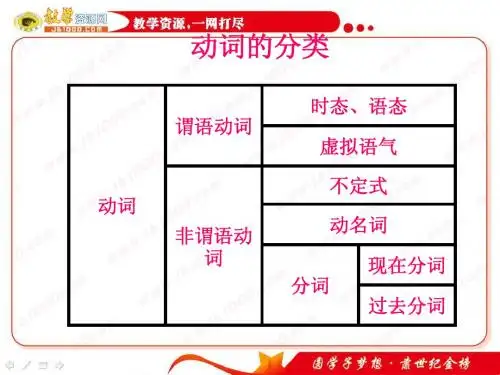
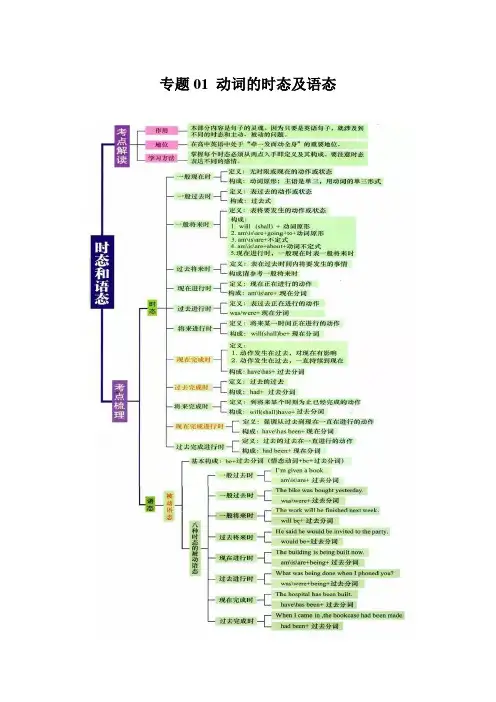
专题01 动词的时态及语态时态知识梳理重点用法1 一般现在时用法:1.be(am,is,are)动词的使用由主语的人称和数决定。
行为动词的第三人称单数加-s/es,其余人称用动词原形。
I am free tonight.我今晚有空。
The boy is ten years old.这个男孩10岁了。
They are students.他们是学生。
Bill often helps others.We like him a lot.比尔总是帮助他人。
我们很喜欢他。
2.表示经常、习惯性发生的动作或存在的状态。
It often rains in our city.我们的城市经常下雨。
3.表示普遍真理和客观真实。
The earth moves round the sun.地球围绕太阳转。
4.表示心理状态或情感的动词往往用一般现在时。
She hates rock music.她讨厌摇滚乐。
5.在时间、条件状语从句中表示将来的动作。
I will call on you as soon as I am free.我空闲时会去拜访你。
提示:一般现在时可以用来代替一般将来时,表示已经预先计划或安排的肯定将要发生的动作,句中常有表示将来时间的状语。
这一用法主要用于下列动词,如果arrive(到达),be (是),begin(开始),come(来到),go(去),leave(离开),reach(到达),start(出发)等。
The train leaves at eight o’clock.火车8点钟开车。
注意:一般现在时常用的时间状语有:today今天often经常always一直sometimes有时usually通常seldom很少on Sunday在星期天every day/week/morning每天/每周/每天早上重点用法2 一般过去时用法:1.be(was/were)动词的使用由主语的人称和数决定。
行为动词都要用过去式。
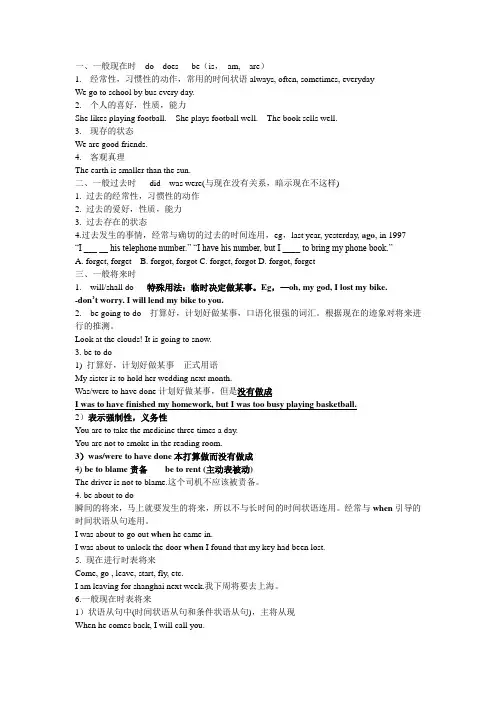
一、一般现在时do does be(is,am, are)1.经常性,习惯性的动作,常用的时间状语always, often, sometimes, everydayWe go to school by bus every day.2.个人的喜好,性质,能力She likes playing football. She plays football well. The book sells well.3.现存的状态We are good friends.4.客观真理The earth is smaller than the sun.二、一般过去时did was were(与现在没有关系,暗示现在不这样)1. 过去的经常性,习惯性的动作2. 过去的爱好,性质,能力3. 过去存在的状态4.过去发生的事情,经常与确切的过去的时间连用,eg,last year, yesterday, ago, in 1997 “I _____ his telephone number.” “I have his number, but I ____ to bring my phone book.”A. forget, forgetB. forgot, forgotC. forget, forgotD. forgot, forget三、一般将来时1. will/shall do 特殊用法:临时决定做某事。
Eg,—oh, my god, I lost my bike.-don’t worry. I will lend my bike to you.2. be going to do 打算好,计划好做某事,口语化很强的词汇。
根据现在的迹象对将来进行的推测。
Look at the clouds! It is going to snow.3. be to do1) 打算好,计划好做某事正式用语My sister is to hold her wedding next month.Was/were to have done计划好做某事,但是没有做成I was to have finished my homework, but I was too busy playing basketball.2)表示强制性,义务性You are to take the medicine three times a day.You are not to smoke in the reading room.3)was/were to have done本打算做而没有做成4) be to blame责备be to rent (主动表被动)The driver is not to blame.这个司机不应该被责备。
高考英语时态和语态详解动词的时态和语态一、时态1、一般现在时(do/does; is/am/are)①表示现在的情况、状态或特征。
例:He is a student.他是一个学生。
②表示经常性、习惯性动作。
例:He always helps others.他总是帮助别人。
③客观事实和普遍真理。
例:The earth moves the sun.地球绕着太阳转。
④表示一个按规定、计划或安排要发生的动作。
仅限于某些表示“来、去、动、停、开始、结束、继续”等的动词,可以与表示未来时间的状语搭配使用。
常见的用法是:飞机、火车、轮船、汽车等定期定点运行的交通方式。
例:The next train leaves at 3 o'clock this afternoon.下一趟火车今天下午3点开车。
⑤在时间、条件和让步状语从句中经常用一般现在(有时也用现在完成时)表示将的来事情。
(即:主将从现原则)例:I will call you as soon as I arrive at the airport.我一到机场就会给你打电话。
When you have finished the report, I will have waited for about 3 hours.等你完成这份报告的时候,我就已经等了将近3个小时了。
2、现在进行时(am/is/are doing)①表示此时此刻正在发生的事情。
例:He is listning to the music now.他现在正在听音乐。
②表示目前一段时间内一直在做的事情,但不一定此时此刻正在做。
例:I am studying computer this term.这个学期我一直在学习计算机。
③现在进行时可以表示将来的含义。
瞬时动词的进行一定表将来。
例:I am leaving.我要离开了。
持续动词的进行只有有将来的时间状语或有将来语境中才表将来。
例:I am travelling next month.下个月我要去旅行。
高考英语单选的语法知识点高考是每个学子都非常重要的一门考试,其中英语作为一门重要科目,占据了很大的比重。
在英语考试中,单选题是经常出现的题型之一,它考察了学生对语法知识的理解和运用能力。
本文将介绍一些高考英语单选题中常见的语法知识点,帮助大家更好地备考。
一、时态1. 一般现在时:一般现在时表示现在的状态、经常性的动作或客观真理。
例如:I usually (go/goes) to the gym on weekends.答案:go2. 一般过去时:一般过去时表示过去发生的动作或状态。
例如:He (buy/bought) a new car last week.答案:bought3. 现在进行时:现在进行时表示现在正在进行的动作。
它由be动词的相应形式加上动词的ing形式构成。
例如:They (play/are playing) football in the park now.答案:are playing二、被动语态1. 一般现在时的被动语态:一般现在时的被动语态由助动词be的相应形式加上动词的过去分词构成。
例如:The cake (makes/is made) by my mother.答案:is made2. 一般过去时的被动语态:一般过去时的被动语态是由助动词was/were的相应形式加上动词的过去分词构成。
例如:The book (give/was given) to me by my teacher.答案:was given3. 一般将来时的被动语态:一般将来时的被动语态是由助动词will be加上动词的过去分词构成。
例如:The party (hold/will be held) next week.答案:will be held三、连接词1. 并列连词:并列连词用于连接两个并列的词、短语或句子。
例如:He likes to play (tennis/basketball) and (listen to music/watch movies).答案:tennis, listen to music2. 关联连词:关联连词用于连接两个具有逻辑关系的句子。
一般现在时——高考英语重点时态语态满分攻略满分清单:一、构成一般现在时由动词原形或动词的第三人称单数形式构成。
be 动词的一般现在时形式为is,am,are。
大部分第三人称单数形式:二、用法1.表示现在的情况状态客观事实或真理。
The sun rises in the east.太阳在东方升起。
2.表示习惯性、经常性的动作或状态。
(常与always,often,seldom,usually,sometimes等连用。
)He often works out in the morning他经常在早上锻炼。
3.在时间、条件或让步状语从句中通常用一般现在时代替一般将来时。
The harder you study, the more progress you will make.你学习越努力,你取得的进步就越大。
4.表示按时间表、时刻表等将要发生的动作。
(常用动词为go,come,open,leave,arrive,begin,start,return,close,take off 等。
)The plane takes off at 8 a.m. tomorrow.飞机将在明天上午8 点起飞。
三、被动语态的构成一般现在时:am/ is /are + doneThe tables are firmly fixed to the floor.这些桌子被牢牢地固定在地板上。
满分练习:1. Neither your sister nor mine _____the good news. Let's tell them.A. knowB. knowsC. knewD. known2. Our collective ability to be resilient and successful is held back, because we ________ a period of recovery.A. lack ofB. are in lack ofC. lackD. are lacking of3. Mike _______ very hard. When I saw him at eleven last night, he was still studying in his room.A. has studiedB. studiesC. studiedD. will study4. The plane ______ at 10:00 according to the schedule, so you must try to be at the airport by 9: 00.A. is being taken offB. will take offC. took offD. takes off5. He will have learned the guitar for eight years by the time he ________ from the university next year.A. will graduateB. graduatesC. will have graduatedD. is to graduate6. —What a large collection!—Believe it or not, my interest in stamp collecting _____ primary school days.A. dates fromB. dated back toC. dating back toD. was dated from7. Single-use plastic bags are used at most a few times before they ________ away.A. are thrownB. have thrownC. were thrownD. thrown8. Our class ________ 55 lively boys and girls, and Mr. Yu is strict with each of us.A. makes upB. is made up ofC. is built upD. builds up9. All customers _______ to take their temperatures when they enter the supermarket.A. is askedB. was askedC. are askedD. were asked10. —So what is the procedure?—All the applicants _______ before a final decision is made by the authority.A. interviewB. are interviewingC. are interviewedD. are being interviewed11. There's a system where the waste _____ (dispose) of using the principles of ecology.12. To go to bed early and get up early _____ (make) a man healthy, wealthy and wise.13. I prefer to go to the mall near the post office, because the furniture there _____ (be) much cheaper.14. The project is _____ (schedule) to start on in Guangzhou City.15. At the Cold Food Festival, the use of fire _____ (ban) and people only eat cold food to mark the death of Jie Zitui.答案以及解析1. 答案:B解析:考查主谓一致和一般现在时。
高考英语的时态知识点(经典版)编制人:__________________审核人:__________________审批人:__________________编制单位:__________________编制时间:____年____月____日序言下载提示:该文档是本店铺精心编制而成的,希望大家下载后,能够帮助大家解决实际问题。
文档下载后可定制修改,请根据实际需要进行调整和使用,谢谢!并且,本店铺为大家提供各种类型的经典范文,如演讲稿、总结报告、合同协议、方案大全、工作计划、学习计划、条据书信、致辞讲话、教学资料、作文大全、其他范文等等,想了解不同范文格式和写法,敬请关注!Download tips: This document is carefully compiled by this editor. I hope that after you download it, it can help you solve practical problems. The document can be customized and modified after downloading, please adjust and use it according to actual needs, thank you!In addition, this shop provides you with various types of classic sample essays, such as speech drafts, summary reports, contract agreements, project plans, work plans, study plans, letter letters, speeches, teaching materials, essays, other sample essays, etc. Want to know the format and writing of different sample essays, so stay tuned!高考英语的时态知识点时态(tense)是一种动词形式,不同的时态用以表示不同的时间与方式。
消费者权益保护法律知识题库一、填空题1、新修订的《消费者权益保护法》的正式实施时间是:2014年3月15日2、某消费者装修商品房,与甲装修公司签订了装修合同,装修完工后消费者搬入,发现装修存在瑕疵,根据新消费者权益保护法的规定,在消费者接受该装修好的商品房之日起(6个月内由甲装修公司承担有关举证责任。
3、经营者提供的商品或者服务不符合质量要求的,没有国家规定和当事人约定的,消费者可以自收到商品之日起(7日内退货。
4、经营者采用网络、电视、电话、邮购等方式销售除消费者定作的、鲜活易腐的、在线下载或者消费者拆封的音像制品、计算机软件等数字化商品、交付的报纸期刊以及其他根据商品性质并经消费者在购买时确认不宜退货的商品外,消费者有权自收到商品之日起(7日内退货,且无需说明理由。
5、国家制定有关消费者权益的法律、法规、规章和强制性标准,应当听取(消费者和消费者协会等组织的意见。
6、小王在某手机店挑选手机,挑选了将近一个小时,但最后觉得没有一款适合自己的,打算离开,但该手机店店员拦住他,要求其购买一部。
问该店员的行为侵犯了小王的(自主选择权。
7、我国新修订的《消费者权益保护法》中,消费者享有的权利有…9项‟8、消费者协会有权受理消费者投诉并对投诉事项进行(调查、调解9、2014年“3〃15”国际消费者权益日活动的主题是(新消法新权益新责任。
10、消费者的消费客体是(商品和服务11、在保修期内(二次次修理仍不能正常使用的,经营者应当负责更换或者退货。
12、手机移动电话机、车载移动电话机、固定电话机的有效“三包”期限为(一年13、“三〃八”购物节时,陈小姐在某大型购物网站上看到一双高跟鞋,款式新颖,价格也很便宜,陈小姐毫不犹豫点击了购买,并支付了货款。
收到货后,陈小姐觉得这双高跟鞋虽然新颖,但颜色跟网页上的图片出入很大,于是便联系上网店店主,要求退货,并愿意承担来往的运费,但遭到店主的拒绝。
该店主违反了新《消法》的(七天无理由退货制规定。
动词时态用法归纳总结05一般现在时讲义-2022届高考英语语法复习学习专题英语动词时态用法归纳一般现在时知识点总结一、构成由动词原形表示,第三人称单数后要加-s,be和have的有特殊人称形式。
二、基本用法(1) 表示现在经常性或习惯性的动作,常与often, usually , every day 等时间状语连用。
如:Children often dislike homework. 孩子们通常都不喜欢家庭作业。
He does the cooking and she does the washing. 他做饭,她洗碗碟。
The monitor is a person who seldom asks a boon of others. 我们班长是个很少请人帮忙的人。
Sometimes I help my mother in the house. 有时候我帮助妈妈做家务。
We go for walks in the fields occasionally. 我们偶尔去田野里散步。
(2) 表示现在的状态、特征、职业、能力或感觉等。
如:He seems to feel a bit down today. 他今天好像感到情绪不佳。
This cloth you bought is cheap, but it wears well. 你买的这种布便宜,但耐穿。
He works as a driver. 他以开汽车为业。
He speaks English well. 他英语说得好。
He likes skating and so does she. 他喜欢滑冰她也喜欢滑冰。
Now more and more city adults spend their leisure time trying to improve themselves at school or college. 现在城市里越来越多的成年人利用业余时间到学校或大学去深造。
高考英语一般现在时用法详解(1)一、单项选择一般现在时1.Some believe that China faces similar problems as devices meant to fight crime _______ to invade privacy.A.beginning B.begun C.begin D.had begun【答案】C【解析】考查时态。
句意:有人认为,中国面临类似的问题,如用来打击犯罪的装置开始入侵个人隐私。
as引导原因状语从句中,devices是主语,meant to fight crime是后置定语。
缺谓语,根据主句faces可知,用一般现在时。
故选C。
2.The Small Goose Pagoda in Xi’an, one of the 22 Silk Road relics located in China, _______ back in 707 during the Tang Dynasty.A.dated B.was datedC.dates D.is dating【答案】C【解析】试题分析:考查动词短语和时态。
短语date back to追溯到....;从....开始有;该句型没有被动语态,也没有进行时。
通常都使用一般现在时表示从现在时间某一事物能够追溯到的时期。
故C项正确。
【名师点睛】当分词做状语的时候,要特别考虑主被动关系以及时间的先后关系。
如果构成分词的动词与句子的主语构成主动关系,就使用现在分词做状语;当二者构成被动关系,使用过去分词做状语。
如果分词的动作发生在谓语动词之前,就使用分词的完成式。
如果分词与句子的主语没有关系,可以使用状语从句或者独立主格结构。
考点:考查动词短语和时态3. Temperatures________ quite dramatically at night in mountains, so put on some warm clothes before going out.A.are dropped B.dropC.are being dropped D.have dropped【答案】B【解析】试题分析:句意:山里的气温晚上下降得厉害,所以出门前穿上一些暖和的衣服。
山里的气温到晚上骤降是自然状况,应该用一般现在时的主动语态。
故选B。
考点:考查谓语动词的时态和语态。
4.Our class _______ forty-five students, in other words, forty-five students ______ our class. A.consists of, are made up of.B.is consisted of, make up.C.consists of, make up.D.is consisted of, are made up of.【答案】C【解析】试题分析:考查词组辨析。
consist of 表示包括......,由......组成;make up 组成;故选C。
考点:考查词组辨析。
5.A long road tests a horse’s strength and a long-term task ________ a man’s heart. A.proves B.will prove C.is proving D.has proved【答案】A【解析】试题分析:考查动词时态。
句意:路遥知马力,日久见人心。
这是一条谚语,故用一般现在时态,故选A。
考点:考查动词时态6.Honesty ___________ an important role in a child’s ability to succeed in school and later life. A.played B.playsC.had played D.has played【答案】B【解析】试题分析:考查时态。
句意:诚实对一个孩子在学校和以后生活中取得成功的能力起着重要的作用。
表示客观事实用一般现在时态,Honesty是第三人称单数形式,故选B。
考点:考查时态7.I intend to buy that kind of clothes because I ____ that they _____ well.A.have told; wash B.have been told; washC.was told; washed D.have been told; are washed【答案】B【解析】考察时态。
根据题意,我想买那种衣服,因为有人告诉过我他们洗起来不错。
可知从句内容为过去已经完成的动作,故用过去完成时态。
他们洗起来不错则是一个客观存在的事实,过去存在,现在及将来都会存在,故用一般现在时态。
选B。
8.The teacher told us that light ________ faster than sound.A.travelled B.has travelledC.travels D.was travelling【答案】C【解析】试题分析:直接引语如果是客观事实或真理,变为间接引语时,不管主句用什么时态,间接引语的时态不变。
9.---The CDs by the star ______ well.---That’s true. More than ten million copies have been sold out so far.A.are sold B.sellC.sells D.is sold【答案】B【解析】试题分析:句意:--这个明星的CD卖的好。
--那是真的,十万多张唱片都被卖了。
这里强调CD的特点是好卖,强调的是CD本身的属性,不是强调卖这个动作,用主动表示被动,选B。
考点:考查主动表被动10.We have no idea what air we will be breathing in the future if we anything to stop hazy weather.A.hadn’t done B.didn’t doC.haven’t done D.don’t do【答案】D【解析】考查时态。
句意为:我们不知道如果我们不采取措施阻止雾霾天气的话,我们未来将呼吸什么样的空气。
根据主句的时态和时间状语“in the future”可知,if条件句要用一般现在时表将来。
根据句意可知选D。
11.Her parents require that she ________ her homework before she ________ TV.A.will finish; watches B.finishes; watchesC.finish; watches D.finishes; will watch【答案】C【解析】考查require后的宾语从句和时间状语从句。
require后的宾语从句用should+动词原形,其中should可以省略,第一空填finish;在宾语从句中,含有before引导的时间状语从句,主句是should+动词原形,则从句用一般现在时态,she是单数第三人称,故第二空填watches。
由此可知答案为C。
12.As the town ______ good restaurants, we just treated the foreign friends to some local food at home yesterday.A.didn’t have B.doesn’t haveC.won’t have D.hadn’t had【答案】B【解析】试题分析:考查动词时态及句意理解。
句意:因为镇上没有好的餐馆,我们只好在家里用当地食品招待外国客人。
虽然句中用yesterday作为时间状语,但是没有好餐馆是现在这一段时间的一个事实,所以应该采用一般现在时态,故B正确。
考点:考查动词时态及句意理解13.Experience is a hard teacher because she ________ the test first, the lesson afterwards. A.gives B.has given C.was giving D.would give【答案】A【解析】句意:经验是一名苛刻的老师,因为她总是先考试再给你上课。
表达的是客观事实,要用一般现在时态;主语she是第三人称单数,谓语动词give要用第三人称单数形式,故选A。
【名师点睛】一般现在时表示通常性、规律性、习惯性、真理性的状态或者动作有时间规律发生的事件的一种时间状态。
在使用时尤其要注意主语是第三人称单数时,谓语动词要用三单形式,比如本题gives。
14.That children ______meet with setbacks is a matter of necessity as they_____, so parents don’t wor ry about that.A.shall; grew up B.must; grew up C.can; grow up D.will; grow up【答案】D【解析】考查情态动词和时态。
will 表示“不可避免性”。
如:Boys will be boys. 句中的don’t worry说明了该句用一般现在时。
15.Professor Williams keeps telling his students that the future ___ to the well-educated. A.belongs B.is belongedC.is belonging D.will be belonged【答案】A【解析】考查belong的用法。
Belong to属于;不用被动语态。
句意:威廉教授坚持告诉学生们,未来属于受过良好教育的人,故A正确。
16.Theoretically, a good screwdriver should last a lifetime, but it rarely___________, usually because it is used at one time or another as ___________ some other tool.A.should, a favor for B.should, a lack ofC.does, a way of D.does, a substitute for【答案】D【解析】试题分析:考查固定搭配。
句意:理论上来说,一个好的螺丝钉能用它的试用期那么久,但是很少会用这么久,通常它都是被用作代替其它的工具。